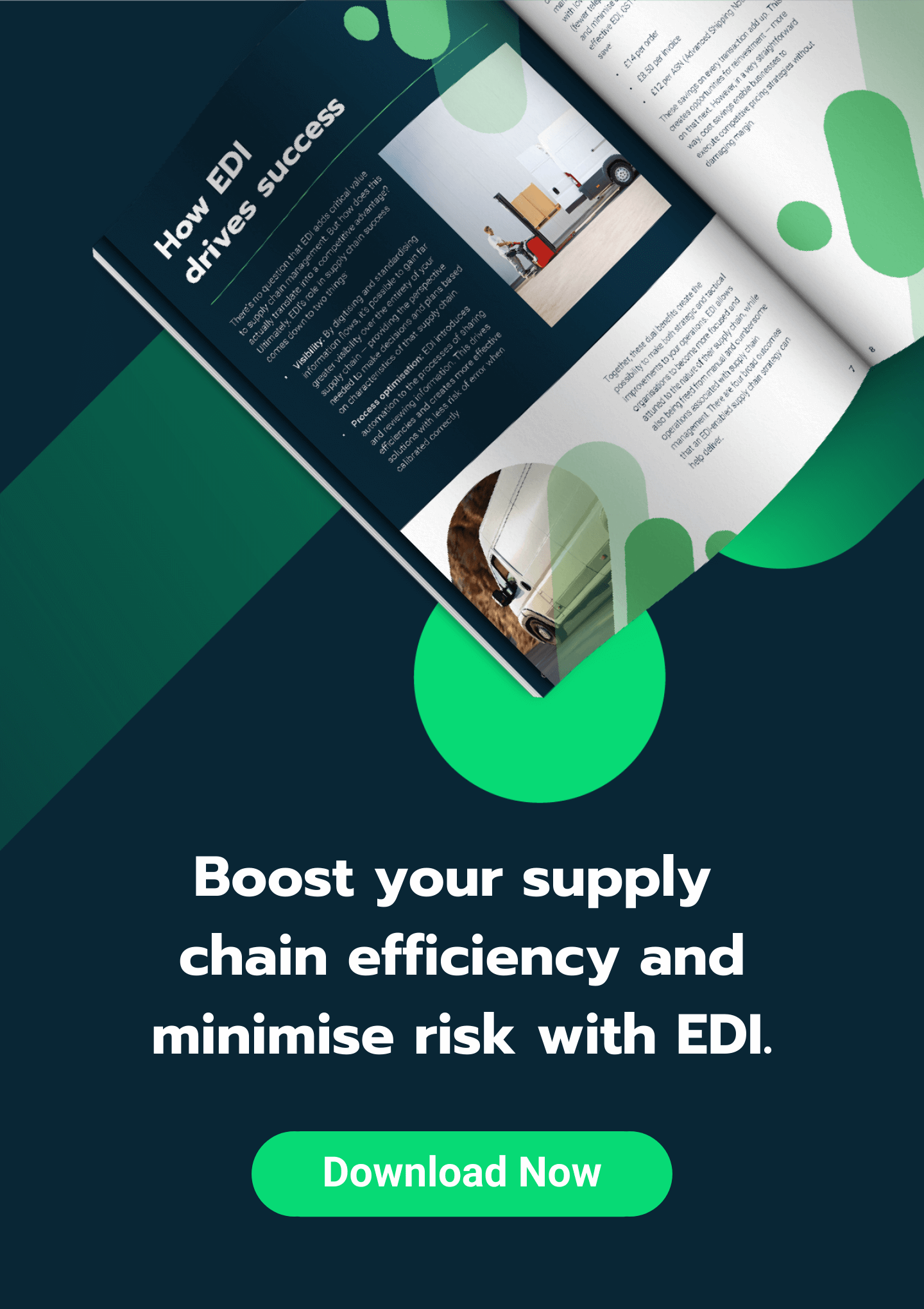Cloud-Based EDI Solutions vs On-Premise
The disruptive events of 2020 highlighted a number of opportunities for improvement and growth. These events also highlighted the critical importance of effective, transparent supply chain management.
If you’re considering an EDI (Electronic Data Interchange) implementation to sharpen your supply chain management and deliver better outcomes in 2021, you’re not alone. But this broader business decision comes with a whole new set of choices. Deciding between an on-premise and cloud-based EDI solution is a critical early choice that will impact how you use EDI and the outcomes it can deliver.
In this blog, we will explain the ins and outs of both on-premise and cloud-based EDI tools. We’ll also explore new developments in cloud-based EDI and the benefits it brings, including flexibility when it comes to application and management.
Ready to find out more? Let’s get started.
On-premise EDI
On-premise EDI most closely aligns with Direct EDI (otherwise known as point-to-point EDI, one of the most traditional EDI solutions) — but the term is more specifically defined by on-premise infrastructure. On-premise EDI exists on-site and is deployed via corporate-owned EDI software operated from a business’s in-house server and connected to an ERP system to exchange EDI transactions. Of course, this setup requires internal resources including a server, a network, an EDI software package license and in-house support staff including EDI-knowledgeable IT personnel.
What’s good about this solution
The primary benefit of using an on-premise solution is that it gives you full control. This control means that you can manage point-to-point connections and various security considerations throughout the many protocols yourself.
Total command over the transformation and integration of data in-house can provide swift and timely changes — eliminating the need to wait around and pay for third-party support teams. However, the flip side here is that you must have the EDI capabilities necessary to provide this support yourself.
A secondary benefit of on-premise EDI is that there are no inherent additional costs. By comparison, with cloud-based software, you’d need to pay for data and provider fees.

What this solution lacks
While on-premise EDI does offer full control, its ‘self-service’ nature means that you need a competent in-house team to avoid any costly EDI implementation or management issues. As many organisations discover when attempting to build in-house teams, EDI management requires increasingly rare and in-demand skill sets. It’s also important to keep in mind not only your internal EDI skills, but those of your suppliers and customers. EDI is a two-way street, and outsourcing to a cloud-based provider can reduce the operational and cost-based risks, while minimising the need for EDI skills across the board.
Another downside of on-premise tools is that the EDI software can slow down deployment time and onboarding processes for trading partners, leading to lost revenue and slower data processing times. In-house EDI resources typically cover numerous EDI roles — e.g. support, new business, transformation and integration. Supply chain deployments of any scale consume significant numbers of resources and require a depth of knowledge across many areas of EDI, including standards and security protocols, as well as continuous support and maintenance of existing relationships.
In today’s world, it’s increasingly common for organisations to have hundreds or even thousands of trading partners (within a global supply chain network), which makes minimising onboarding time and simplifying varying data formats through mapping and translation key.
Who should use on-premise EDI
- Companies who are fully confident in their existing in-house EDI expertise
- Businesses with a relatively low number of stable trading relationships
- Organisations dealing only with trading partners with existing EDI capabilities
Finally, on-premise solutions are often inflexible and difficult to scale. One of the top reasons businesses use EDI is to reduce complexity. However, if you are engaging with partners using different communication protocols and message formats, an on-premise EDI system can rapidly make your processes and communication even more complicated.
Cloud-based EDI
Cloud-based EDI refers to a growing number of web-based, off-premise tools that enable businesses to send, receive, store and manage electronic trading information. As you probably already know, when a tool is ‘in the cloud’ it is accessed and operated over a network connection instead of an on-premise computer. Both EDI via VAN (Value Added Network) and Web EDI are examples of cloud-based, integrated solutions.
Suggested reading: If you want to learn more about these specific variations of EDI, check out our blog — Different Types of EDI Compared.
What’s good about this solution
Cloud-based tools are cost-effective and can increase operational efficiency, boost end-to-end visibility capabilities and promote smoother collaboration. In the simplest terms, cloud-based EDI means there’s less to build and less to manage.
From a customer’s point of view, there is only one link to the service. Outbound connections may even already exist in the VAN service, making the ‘build’ process much simpler for the VAN provider as well. The management of a VAN connection, whether interconnect or direct, is made and supported by the VAN provider. The outcome is a system that is far easier for any customer to use and maintain.

A VAN system is also easier to scale because the provisioning of resources and integration of new supply chain partners is often delivered by the EDI provider. Basically, you are outsourcing the construction and maintenance of an effective EDI system, and all that’s left for you to do is use that system.
Cloud-based EDI tools can also make the use of an EDI system easier. For example, WebEDI covers a range of in-browser tools, most of which are about making EDI more accessible — e.g. creating web forms that enable anyone to input information directly into an EDI system, regardless of their technical expertise. Even if this isn’t important for you, it might be critical for your supply chain partners.
Finally, cloud-based tools, especially those operating in-browser like Web-EDI, make B2B integrations easy, allowing you to quickly onboard new trading partners, even those without any EDI expertise. This is a significant selling point for businesses with trading partners who lack tech and EDI infrastructure or know-how.
What this solution lacks
Although cloud-based solutions remove much of the risk (including the cost risks of implementation and management issues) associated with on-premise EDI, you will still be responsible for paying for data costs or support services. You are also depending on a third-party to deliver critical services for your business. Some businesses migrating to the cloud might also face integration challenges, especially with on-premise legacy systems, but the right service provider can help you with this.
Who should use cloud-based EDI tools
- Businesses with limited or no in-house EDI expertise
- Companies trading with partners who lack EDI know-how or IT skills
- Organisations seeking to simplify their supply chain and EDI management
- Businesses looking for more flexibility and scalability
The future of EDI
So which type of EDI comes out on top? At Data Interchange, we believe that the future of EDI will be defined by flexible and multi-faceted solutions. “Hybrid EDI solution”, that pulls on multiple types of EDI (including on-premise and cloud-based tools), can enable businesses big and small to harness the benefits of different EDI systems at the right time. A combination of managed services, cloud-based tools and sophisticated integrations can simplify EDI adoption and rollout, allowing you to focus on growing your business.
This combination of managed services and self-service tools creates a category that we call “EDI-as-a-Service”. This encompasses both the delivery of software-as-a-service (for example, Web EDI) along with the outcome of effective EDI implementation delivered as-a-service — e.g. managed service.
No matter how complicated your supply chain, or how limited your EDI expertise, effective EDI is within your grasp. Working with an EDI-as-a-Service provider, like Data Interchange, gives you on-demand access to a team of experts — eliminating the need for a costly in-house team. Remember: as we move into the 2020s, there’s no question that EDI is moving towards the cloud — but more fundamentally, it’s moving towards simplicity.
Ultimately, EDI is all about simplifying your supply chain management. But it needs to be simple to use for that goal to come to fruition, and for 100% EDI adoption to become a reality. On-premise solutions still have a role to play. But, increasingly, an effective on-premise solution needs to be augmented with cloud-based capabilities to be accessible across your entire supply chain. What you need is a good EDI provider, so start your EDI journey and plan your future with Data Interchange today.




























































































































